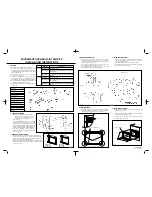
50
50
PreSonus AudioBox
™
22/44VSL
Ov
erv
iew
Ho
oku
p
Co
nn
ect
ing
to a
Co
m
pu
ter
So
ftw
are
: Vi
rtu
al S
tud
ioL
ive
SL R
em
ote
,
and S
tudio O
ne A
rtist
Tu
tor
ials
Te
ch
nic
al
Inf
orma
tion
Tro
ub
les
ho
otin
g
and
W
arr
an
ty
5
Tutorials
Tu
tor
ials
5.2 A Brief Tutorial on Dynamic Processing
Attack
. Attack sets the speed at which the compressor acts on the
input signal. A slow attack time allows the beginning envelope of a
signal (commonly referred to as the initial transient) to pass through the
compressor unprocessed, whereas a fast attack time immediately subjects
the signal to the ratio and threshold settings of the compressor.
Release
. Release sets the length of time the compressor takes to return the gain
reduction back to zero (no gain reduction) after the signal level drops below the
compression threshold. Very short release times can produce a very choppy or
“jittery” sound, especially in low-frequency instruments such as bass guitar. Very long
release times can result in an overcompressed sound; this is sometimes referred to as
“squashing” the sound. All ranges of release can be useful at different times, however,
and you should experiment to become familiar with the different sonic possibilities.
Hard/Soft Knee
. With hard-knee compression, the gain reduction applied to the
signal occurs as soon as the signal exceeds the level set by the threshold. With
soft-knee compression, the onset of gain reduction occurs gradually after the signal
has exceeded the threshold, producing a more musical response (to some folks).
Auto
. Places a compressor in automatic attack and release
mode. The attack and release knobs become inoperative and
a preprogrammed attack and release curve is used.
Makeup Gain
. When compressing a signal, gain reduction usually results
in an overall reduction of level. The gain control allows you to restore
the loss in level due to compression (like readjusting the volume).
Compressor Sidechain
. The sidechain jack interrupts the signal that the compressor
is using to determine the amount of gain reduction it should apply. When no
connector is inserted into this jack, the input signal goes directly to the compressor’s
control circuitry. When a connector is inserted into this jack, the signal path is broken.
The control signal can then be processed by an equalizer, for example, to reduce
sibilance (de-essing) in a vocal track. The control signal is then returned to the unit via
the connector. One common application for a sidechain is when using a compressor
to reduce the level of music or other background sound whenever a narrator speaks
or vocalist sings, allowing the voice to be clearly heard. In this application, the
vocal signal is routed to the sidechain input, while the music is routed through the
main compression circuitry. Now the compressor will automatically duck—that is,
reduce the level of—the music whenever the narrator speaks or the vocalist sings.
Expansion
There are two basic types of expansion: dynamic and downward. Expansion increases
the dynamic range of a signal after the signal crosses the expansion threshold.
Dynamic expansion is basically the opposite of compression. In fact, broadcasters use
dynamic expansion to “undo” compression before transmitting the audio signal. This
is commonly referred to as
companding,
or COMPression followed by expANDING.
By far the most common use of expansion is downward expansion. In contrast
to compression, which decreases the level of a signal after it rises above the
compression threshold, expansion decreases the level of a signal after the
signal goes below the expansion threshold. The amount of level reduction is
determined by the expansion ratio. For example, a 2:1 expansion ratio reduces
Содержание AudioBox 22VSL
Страница 78: ...74 74...















































